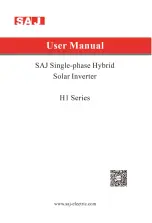
8
Battery Configuration
Note:
For heavy-duty use, manufacturer recommends an ANL fuse be added as close as possible to the power source (battery)
positive terminal. The fuse amperage must be appropriate to allow simultaneous operation of all the AC appliances to be
powered, with delay characteristics that allow for the momentary high start-up current requirements of inductive loads.
Use the recommended fuse block (fuse holder) and fuse, or an electrical equivalent. See the “Specifications” section of
this Instruction Manual to determine the proper fuse for your inverter. For full rated and motor start-up surge output,
ensure that the installation is configured to handle the full load.
Determining Battery Size
To determine the minimum battery size you will need to operate appliances from your inverter, follow these steps:
1. Determine the wattage of each appliance and/or tool you will need to simultaneously operate from the inverter.
To do this, read the labels on the equipment to be operated.
2. Estimate the number of hours the equipment will be in use between battery recharges.
3. Determine the total watt-hours of energy use, the total running time and the average power consumption.
Keep in mind that some appliances are not drawing the same power continuously. For example, a typical home-use
coffee maker draws 500 watts during brew time (approx. 5 minutes) but maintains the pot temperature at only about
100 watts. Typical use of a microwave is only for a few minutes, sometimes at low power.
Protective Features
The inverter has electronic circuit protection against overload and short circuit conditions; and monitors for the
following potentially hazardous conditions:
Low Battery Voltage
—This condition is not harmful to the inverter, but could damage the power source. An alarm
will sound when input voltage drops below 10.5 volts, and the inverter will automatically shut down when input
voltage drops below 10.0 volts. This indicates that the DC (battery) power source needs to be charged, or there is
an excessive voltage drop between the battery power source and the inverter. When the condition is corrected, the
inverter will automatically restart.
Over Voltage Protection
— The inverter will automatically shutdown when input voltage exceeds 16 volts DC.
Overload Protection
— The unit will automatically shut down when the continuous draw exceeds the inverter’s
wattage rating. Reduce the load and manually restart.
Over Temperature Protection
— If the temperature inside the inverter reaches 150°F, the unit will automatically
shut down. Allow the inverter to cool for at least 15 minutes before restarting after a heat-related shutdown. Unplug
the inverter from the power source and disconnect all appliances or tools from the inverter’s outlets while cooling.
If the Digital display on the optional TH-IRC or TH-RC, displays a fault code follow the steps outlined in the
“Troubleshooting” section of this Instruction Manual. The Fault LED will light if there is an excessive voltage drop
between the (battery) power source and the inverter.
Note:
Reverse polarity or short circuit condition may cause external or internal fuses to open and may cause irreversible
damage to the Power Inverter. Take extra care to ensure a proper polarity hook-up.
CAUTION
• If turning the ON/OFF Switch off, then on again does not reset the inverter, DO NOT ATTEMPT TO OPEN THE
INVERTER. Opening the inverter for any reason will void the warranty. The unit must be returned to manufacturer
for testing and repair by professional factory technicians.




































